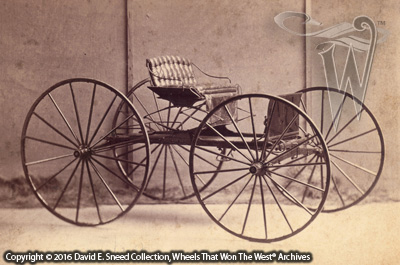Recently, a friend pointed out a highwheel, wood wagon advertised on the internet. The description of the vehicle claimed it to be a certain brand. At first glance, it looked like a decent barn-find at a suitable price. Upon closer inspection, though, it became clear that the wagon was an assortment of mismatched parts – very likely NOT a true ‘barn-find’ as stated in the ad. It’s an important observation as the non-original condition negatively affected the collectable value of the piece. It was another reminder of just how careful collectors need to be as well as how convoluted the evaluation process can be.
I’m often asked to identify, date, andassess the originality of vehicles. Manytimes, there is an expectation that the job should be fairly straight-forwardand easy. Done thoroughly, though, thereis nothing simple about it. In adetailed review, every part should be noted and confirmed as a match to both aspecific era and brand. At times, thatcan be a tall order to fill. Why? Because, we’re talking about an industry thatlasted over 200 years, included tens of thousands of makers, and produced countless variations in vehicle sizes, styles, technologies, and construction features.
 |
| Original maker photos and catalog images can be extremely helpful when evaluating a surviving wagon from the same builder and era. |
When it comes to making sense of it all,the vast scope of nineteenth and early twentieth century wagon production numbersseem to label this as an impossible subject to get a handle on. It’s why, for the last two-plus decades,we’ve been heavy collectors of early photos and industry materials. The sheer volume of data has given us the privilegeof studying and recognizing the evolutionary moves of individual brands as wellas shifts within the overall industry. That awareness of specific details continues to assist in our owncollecting prowess as well as helping those who have reached out to us forassistance.
A few cases in point… Years ago, I wastold there were no more than a few thousand builders in this industry – maybe 8 or 10 thousandat the very most. Then, we uncovered multiple, primary source accounts putting the number of nineteenth century vehicle makers well into the tens ofthousands. The details made it clear that the days of this industry were more competitive and complicated than many had originallythought. In another instance, Iwas once told that Peter Schuttler is a brand that never changed its wagon constructionor designs. Since then, I’ve heard that statement anumber of times and ‘no’ it is not true. Thimble skeins, according to some, supposedly were not used until the days of the Civil War. Unfortunately, it’s just one more of the many false perceptions that have been repeated enoughthat they’re sometimes accepted as non-supported truths.At the end of the day, digging throughthese myths and helping set the records straight with primary sourcedocumentation is at the core of our mission. After all, the integrity levels of a vehicle (originality, condition,authenticity, completeness, and notable features) have just as much – and maybemore – to do with the overall value as the brand, age, type, and personalprovenance of a set of wheels.
So, when it comes to collecting earlywagons... Who was the best? How manywere made? Where were they sold? When did a particular brand cease buildingvehicles? Why were certain designs used bysome versus the different configurations of others? There are countless questions regularly asked. Some, like the first one in this paragraph,can be subjective. Others, have a moredecisive and historical response. Themore we understand about a particular brand as well as the industry, itself, theeasier it is to make solid investment choices.
Ultimately, every part of these wood-framedvehicles has a story to tell. If we’re lookingat a piece with intent for it to become part of a respected collection, it’simportant to slow down and ‘listen’ to what every element is saying. In the end, a careful and supportableanalysis can mean all the difference between acquiring an average versusexceptional piece. If all goes as planned, next week, we'll share a unique story highlighting the role of wagons as they helped save a legendary part of the American West! See ya then! By the way, if you haven’t signed up to receive this weekly blog via e-mail, just type your address in the "Follow By E-mail" sidebar section above. You'll receive a confirmation e-mail that you'll need to verify before you're officially on board. Once that's done, you'll receive an email every time we update the blog. Please don't hesitate to let us know if we can be of assistance. We appreciate your continued feedback and look forward to sharing even more throughout the year. Have a good week!
Please Note: As with each of our blog writings, all imagery and text is copyrighted with All Rights Reserved. The material may not be broadcast, published, rewritten, or redistributed without prior written permission from David E. Sneed, Wheels That Won The West® Archives.
